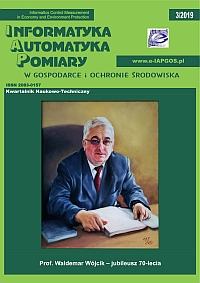Asakura K., Hayashi S.: Improvement of acquisition and analysis methods in multi-electrode array experiments with iPS cell-derived cardiomyocytes. Journal of Pharmacological and Toxicological Methods 75/2015, 17–26.
DOI: https://doi.org/10.1016/j.vascn.2015.04.002
Berul C.I., Aronovitz M.J., Wang P.J., Mendelsohn M.E.: In vivo cardiac electrophysiology studies in the mouse. Circulation 94/1996, 2641–2648.
DOI: https://doi.org/10.1161/01.CIR.94.10.2641
Chechel V., Vlasenko O., Rokunets I.: Patent No. 55671 UA, MPK А61В 5/04. Multichannel system for wireless transfer of action potentials in brain and spinal cord. National Pirogov Memorial Medical University 24/2010, 05836.
Ciaccio E.J., Saltman A.E., Hernandez O.M., Bornholdt R.J., Coromilas J.: Multichannel data acquisition system for mapping the electrical activity of the heart. Pacing and clinical electrophysiology 28/2005, 826–838.
DOI: https://doi.org/10.1111/j.1540-8159.2005.00167.x
Deacon M., Singleton D., Szalkai N., Pasieczny R., Peacock C., Price D., Boyd J., Boyd H., Steidl-Nichols J.V., Williams C.: Early evaluation of compound QT prolongation effects: a predictive 384-well fluorescence polarization binding assay for measuring hERG blockade. Journal of pharmacological and toxicological methods 55/2007, 255–264.
DOI: https://doi.org/10.1016/j.vascn.2006.09.003
Dutta S., Chang K.C., Beattie K.A, Sheng J., Tran P.N., Wu W.W., Wu M., Strauss D.G, Colatsky T., Li Z.: Optimization of an in silico cardiac cell model for proarrhythmia risk assessment. Frontiers in Physiology 23/2017, 616.
DOI: https://doi.org/10.3389/fphys.2017.01025
Food and Drug Administration, HHS. ICH: S7B nonclinical evaluation of the potential for delayed ventricular repolarization (QT interval prolongation) by human pharmaceuticals. Fed. Regist. 70/2005, 61133-4.
Gintant G., Sager P.T., Stockbridge N.: Evolution of strategies to improve preclinical cardiac safety testing. Nature Reviews Drug Discovery 15/2016, 457–471.
DOI: https://doi.org/10.1038/nrd.2015.34
Guth B.D.: Preclinical cardiovascular risk assessment in modern drug development. Toxicological Sciences 97/2007, 4–20.
DOI: https://doi.org/10.1093/toxsci/kfm026
Henry P.D.: Comparative pharmacology of calcium antagonists: nifedipine, verapamil and diltiazem. The American journal of cardiology 46/1980, 1047–1058.
DOI: https://doi.org/10.1016/0002-9149(80)90366-5
Hofer E., Keplinger F., Thurner T., Wiener T., Sanchez-Quintana D., Climent V., Plank G.: A new floating sensor array to detect electric near fields of beating heart preparations. Biosensors and Bioelectronics 21/2006, 2232–2239.
DOI: https://doi.org/10.1016/j.bios.2005.11.010
Kawakami K., Nagatomo T., Abe H., Kikuchi K., Takemasa H., Anson B.D., Delisle B.P., January C.T., Nakashima Y.: Comparison of HERG channel blocking effects of various β blockers–implication for clinical strategy. British journal of pharmacology 147/2006, 642–652.
DOI: https://doi.org/10.1038/sj.bjp.0706508
Lee W., Windley M.J., Vandenberg J.I., Hill A.P.: In Vitro and in Silico Risk Assessment in Acquired Long QT Syndrome: The Devil Is in the Details. Frontiers in physiology 8/2017.
DOI: https://doi.org/10.3389/fphys.2017.00934
Malkin R.A., Pendley B.D.: Construction of a very high-density extracellular electrode array,” American Journal of Physiology-Heart and Circulatory Physiology 279/2000, 437–442.
DOI: https://doi.org/10.1152/ajpheart.2000.279.1.H437
Meyer T., Boven K.H., Günther E., Fejtl M.: Micro-electrode arrays in cardiac safety pharmacology. Drug Safety 27/2004, 763–772.
DOI: https://doi.org/10.2165/00002018-200427110-00002
Moroz V.M., Vlasenko O.V., Rokunets I.L., Chechel V.V., Yoltukhovskii M.V., Yankovskaya L.V.: Coupled Spike Activity in Micropopulations of Motor Cortex Neurons in Rats. Neurophysiology 42/2010, 110–117.
DOI: https://doi.org/10.1007/s11062-010-9138-4
Okada J.I., Yoshinaga T., Kurokawa J., Washio T., Furukawa T., Sawada K., Sugiura S., Hisada T.: Screening system for drug-induced arrhythmogenic risk combining a patch clamp and heart simulator. Science advances 4/2015, 140–142.
DOI: https://doi.org/10.1126/sciadv.1400142
Pavlov S.V., Barylo A.S., Kozlovska T.I., et al.: Analysis of microcirculatory disorders in inflammatory processes in the maxillofacial region on based of optoelectronic methods. Przegląd Elektrotechniczny 93(5)/2017, 114–117.
DOI: https://doi.org/10.15199/48.2017.05.23
Pavlov S.V., Kozhemiako V.P., Kolesnik P.F., et al.: Physical principles of biomedical optics: monograph. VNTU, Vinnytsya 2010.
Pavlov S.V., Kozhemiako V.P., Petruk V.G., Kolesnik P.F.: Photoplethysmohrafic technologies of the cardiovascular control. Universum, Vinnitsa 2007.
Pavlov S.V., Kozlovska T.I., et al.: Calibration of the metrological characteristics of photoplethysmographic multispectral device for diagnosis the peripheral blood circulation. Przegląd Elektrotechniczny 93(5)/2017, 79–82.
DOI: https://doi.org/10.15199/48.2017.05.15
Pavlov S.V., Tuzhanskyy S.E., Kozlovska T.I. , Kozak A.V.: A simulation model of distribution of optical radiation in biological tissues. Visnyk VNTU 3/2011, 191–195.
Pradhapan P., Kuusela J., Viik J., Aalto-Setälä K., Hyttinen J.: Cardiomyocyte MEA data analysis (Cardio MDA) – a novel field potential data analysis software for pluripotent stem cell derived cardiomyocytes. PloS one 8/2013, 73637.
DOI: https://doi.org/10.1371/journal.pone.0073637
Rampe D., Brown A.M.: A history of the role of the hERG channel in cardiac risk assessment. Journal of pharmacological and toxicological methods 68/2013, 13–22.
DOI: https://doi.org/10.1016/j.vascn.2013.03.005
Serkova V.K., Pavlov S.V., et al.: Medical expert system for assessment of coronary heart disease destabilization based on the analysis of the level of soluble vascular adhesion molecules. Proc. SPIE 10445/2017, 104453O.
DOI: https://doi.org/10.1117/12.2280984
Singleton D.H., Boyd H., Steidl-Nichols J.V., Deacon M., de Groot M.J., Price D., Nettleton D.O., Wallace N.K., Troutman M.D., Williams C., Boyd J.G.: Fluorescently labeled analogues of dofetilide as high-affinity fluorescence polarization ligands for the human ether-a-go-go-related gene (hERG) channel. Journal of medicinal chemistry 28/2007, 2931–2941.
DOI: https://doi.org/10.1021/jm0700565
Stett A., Egert U., Guenther E., Hofmann F., Meyer T., Nisch W., Haemmerle H.: Biological application of microelectrode arrays in drug discovery and basic research. Analytical and bioanalytical chemistry 377/2003, 486–495.
DOI: https://doi.org/10.1007/s00216-003-2149-x
Valentin J.P., Hoffmann P., De Clerck F., Hammond T.G., Hondeghem L.: Review of the predictive value of the Langendorff heart model (Screenit system) in assessing the proarrhythmic potential of drugs. Journal of pharmacological and toxicological methods 49/2004, 171–181.
DOI: https://doi.org/10.1016/j.vascn.2004.03.008
Vandenberg J.I., Varghese A., Lu Y., Bursill J.A., Mahaut-Smith M.P., Huang C.L.: Temperature dependence of human ether-a-go-go-related gene K+ currents. American Journal of Physiology-Cell Physiology 291/2006, 165–175.
DOI: https://doi.org/10.1152/ajpcell.00596.2005
Vassilenko S., Valtchev, Teixeira J.P., Pavlov S.: Energy harvesting: an interesting topic for education programs in engineering specialities. Internet, Education, Science (IES-2016), 149–156.
Wójcik W., Smolarz A.: Information Technology in Medical Diagnostics. LondonTaylor & Francis Group CRC Press Reference, London 2017.
DOI: https://doi.org/10.1201/9781315098050







